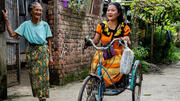-
Country Pages
-
Asia & the Pacific
- أفغانستان
- بنغلاديش
- بوتان
- كمبوديا
- الصين
- الهند
- إندونيسيا
- إيران (جمهورية - الإسلامية)
- جمهورية لاو الديمقراطية الشعبية
- ماليزيا
- جمهورية الملديف
- منغوليا
- ميانمار
- نيبال
- باكستان
- بابوا غينيا الجديدة
- الفلبين
- سري النكا
- تايلند
- تيمور الشرقية
- فييت نام
-
Eastern Europe & Central Asia
- ألبانيا
- أرمينيا
- أذربيجان
- بيلاروسيا
- البوسنة والهرسك
- جورجيا
- كازاخستان
- Kosovo Office
- قيرغيزستان
- مولدوفا، جمهورية
- مقدونيا الشمالية
- صربيا
- طاجيكستان
- تركيا
- تركمانستان
- أوكرانيا
- أوزبكستان
-
الدول العربية
- الجزائر
- جيبوتي
- مصر
- العراق
- الأردن
- لبنان
- ليبيا
- المغرب
- عمان
- فلسطين
- الصومال
- السودان
- الجمهورية العربية السورية
- تونس
- اليمن
-
East & Southern Africa
- أنغولا
- بوتسوانا
- بوروندي
- جزر القمر
- Congo, the Democratic Republic of the
- إريتريا
- إسواتيني
- إثيوبيا
- كينيا
- ليسوتو
- مدغشقر
- الملاوي
- موريشيوس
- موزمبيق
- ناميبيا
- رواندا
- سيشل
- جنوب أفريقيا
- جنوب السودان
- تنزانيا، الجمهورية المتحدة
- أوغندا
- زامبيا
- زمبابوي
-
Latin America & the Caribbean
- الأرجنتين
- بوليفيا (دولة - المتعددة القوميات)
- البرازيل
- شيلي
- كولومبيا
- كوستاريكا
- كوبا
- الجمهورية الدومينيكية
- الإكوادور
- السلفادور
- غواتيمالا
- هاييتي
- الهندوراس
- المكسيك
- نيكاراغوا
- بنما
- باراجواي
- بيرو
- أوروغواي
- فنزويلا (جمهورية - البوليفارية)
- الكاريبي (متعدد البلدان)
-
West & Central Africa
- بنين
- بوركينا فاسو
- كابو فيردي
- الكاميرون
- جمهورية إفريقيا الوسطى
- تشاد
- الكونغو
- كوت ديفوار
- غينيا الإستوائية
- الغابون
- غامبيا
- غانا
- غينيا
- غينيا-بيساو
- ليبيريا
- مالي
- موريتانيا
- النيجر
- نيجيريا
- سان تومي وبرنسيبي
- السنغال
- سيراليون
- توغو
-

UNFPA Myanmar
With abundant natural resources and a dynamic population, Myanmar still faces slow economic growth. Health system weaknesses have kept maternal mortality high, with a majority of deliveries taking place at home, unassisted by skilled birth attendance. UNFPA support began with the 1973 national census. Current programmes align with national plans on reproductive health, HIV/AIDS and women’s rights. They focus on extending high-quality reproductive and sexual health services, emphasizing HIV prevention. UNFPA assistance also helps expand capacities to produce high-quality demographic data, and conduct research and analysis on gender equality issues.
سكان
- Population aged 0-14
- Population aged 15-64
- Population aged 65+
Sexual and reproductive health
- Births attended by skilled health personnel
Family Planning
- Modern method
Education
Gender, Rights, and Human Capital
Harmful Practices
Population Pyramid
العمر المتوقع عند الولادة
Total fertility rate
أخبار
"لِنُحقق الحلم": أن تكون ميانمار أكثر شمولًا للإعاقة
يانغون ، ميانمار - قالت ميو ميو، وهي امرأة تبلغ من العمر 19 عامًا تعيش في يانغون، ميانمار، "تقدمت بطلب للحصول على…

Social Updates
Tweets from UNFPATürkiye